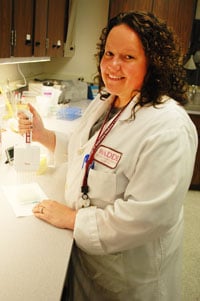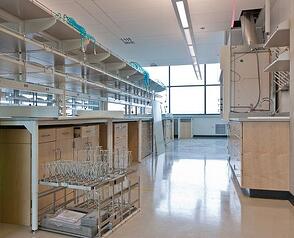Watch out corn, you might just have some competition from the tequila plant in the modern day quest for biofuels. The DOE is funding a new $14.3M multi-lab project to study the CAM pathway in drought tolerant plants like agave, a hearty desert succulent. Dr. John Cushman in the department of Biochemistry and Molecular Biology at the University of Reno is receiving a new $7.6M grant, with a portion going to the University Liverpool in England as collaborators. The rest of the grant, $6.3M, is being divided between the Oak Ridge National Laboratory, Newcastle University, and UT Knoxville. The name of this substantial new grant is: Engineering CAM Photosynthetic Machinery into Bioenergy Crops for Biofuels Production in Marginal Environments. Reno's high desert climate is an ideal center for this innovative biofuel research at a time when rainfall is becoming scarce and new solutions are going to have to be found if we plan to adapt to climate change.
Tags: 2012 Research Funding, University of Nevada, biofuels, UNR, Southwest, 2012, University Research, Funding, Research Funding, Front Line event, NV, new research grants, Reno
 |
| (Courtesy of http://www.abc.net.au/) |
Every week we see commericals on television asking if we have Mesothelioma. By the number of commercials alone you would be right in thinking Mesothelioma is a serious problem. That's why it's particularly important that a major cancer research institution, the University of Hawaii Cancer Center, recently received a $600,000 grant from the Jimmy Valvano Foundation for Cancer Research. The grant was awarded to the research lab of pathologist Michele Carbone to study HGMB1: A Biomarker for Mineral Exposure and Detection of Malignant Mesothelioma. According to Dr. Carbone:
Tags: biomedical research, University of Hawaii, cancer research, 2012, Hawaii, Front Line event, Honolulu, HI, Biomedical Research Funding
 The Washington Animal Disease Diagnostic Laboratory (WADDL) within the College of Veterinary Medicine at Washington State University in Pullman is one of an elite group of veterinary facilities that use sophisticated molecular tools to diagnose disease, with labs for bacteriology, parasitology, pathology, serology, and virology. One threat they've been keeping a particularly keen eye out for this summer is West Nile Virus, which they have in fact found in horses, and which led the State to issue warnings for both animals (to have them vaccinated) and humans (to take extra precautions). West Nile is transmitted from infected birds, through biting mosquitos, and on to larger warm-blooded creatures. Because this has been such a hot, dry summer across most of the U.S., birds and mosquitos are finding themselves more often sharing the same rare watering hole, which may be causing the rise in West Nile cases. West Nile is an example of a zoonotic disease, meaning that it can be transfered between species. The role of veterinary labs like WADDL in tracking and identifying cases of these diseases is doubly important, then, as they work to prevent epidemics in our animals as well as ourselves.
The Washington Animal Disease Diagnostic Laboratory (WADDL) within the College of Veterinary Medicine at Washington State University in Pullman is one of an elite group of veterinary facilities that use sophisticated molecular tools to diagnose disease, with labs for bacteriology, parasitology, pathology, serology, and virology. One threat they've been keeping a particularly keen eye out for this summer is West Nile Virus, which they have in fact found in horses, and which led the State to issue warnings for both animals (to have them vaccinated) and humans (to take extra precautions). West Nile is transmitted from infected birds, through biting mosquitos, and on to larger warm-blooded creatures. Because this has been such a hot, dry summer across most of the U.S., birds and mosquitos are finding themselves more often sharing the same rare watering hole, which may be causing the rise in West Nile cases. West Nile is an example of a zoonotic disease, meaning that it can be transfered between species. The role of veterinary labs like WADDL in tracking and identifying cases of these diseases is doubly important, then, as they work to prevent epidemics in our animals as well as ourselves.
Tags: Washington, WSU Pullman, WA, Northwest, New research facilities, Washington State University, veterinary medicine, 2012, animal science, Front Line event, new construction
One of the things they got was some very thoughtfully designed labs. Though flexibility of design is important to assure future utility, research team leaders gave significant input into the design of their specific labs to make sure those labs were ideal for the type of research that would be carried out within their walls. Project architect Tim Williams, of Zimmer Gunsul Frasca, said in an interview:
“Scientists spend a lot of time in the lab. The UW faculty wanted to look at how we could make that a nicer place to be."
Here are some of the ways they made a nicer science lab building:
 5-story, 90,300sf structure
5-story, 90,300sf structure- Each of the four above-ground floors is divided into a laboratory half and an office half
- The basement is a 28,000sf low-vibration lab space
- Houses more than 15 faculty, 3 research centers and 4 major instrumentation centers
- Aluminum-plate shielding on the building guards against electromagnetic waves
- Natural ventilation in office spaces provided by windows that open
- Optimized ventilation in the lab spaces, replacing air 6 times per hour rather than 10
- Innovative commons spaces
- Green roof gardens
UW officials are proud of the new building, not just because it is state-of-the-art, but also because it's "state-of-the-science." Molecular engineering is a relatively new field, and the UW Molecular Engineering and Sciences Institute (MOLES, the building's primary occupant) sees its mission as exploring a new kind of engineering for the 21st Century: rather than build bridges over rivers (still a noble feat), the new molecular engineer may be building proteins that travel to specific parts of the body. He or she may follow the latest developments in chemistry, biology, physics, nanotechnology and predictive modeling; and his or her research projects will often be interdisciplinary, with colleagues from diverse fields and perhaps different institutions.
Furthermore, if life scientists often pursue basic research to understand the building blocks of life, and engineers build things and occupy themselves with practical mechanics and physical principles, the fusion of the two should have tremendous translational potential. Such is the goal of MOLES and their new collaborative workspace. Per their website:
Research at the Institute for Molecular Engineering & Sciences will be evolvable and dynamic, focusing initially on the themes of CleanTech and BioTech.
Some of the faculty scientists who will be doing research in the new MOLES facility include:
- Patrick Stayton, a professor of bioengineering
- Suzie Pun, a bioengineering associate professor
- David Baker, a biochemistry professor
- Daniel Gamelin, a chemistry professor
- Hugh Hillhouse, a chemical engineering professor
- Christine Luscombe, an associate professor of materials science and engineering
(Dr. David Baker seems to come up in our blog series with regularity. For former blogs citing his work, read the following:)
Computational Biology Scientist at UW Develops New Protein Structure
Crowdsourcing Research Challenge by UW Scientists a Game Changer?
Biotechnology Calendar, Inc. will hold 3 professional tradeshow events focusing on Washington state's bioscience technology and the research partnerships between scientists and the science equipment industry next month on these dates:
- 10/23/2012 -- Washington State University BioResearch Product Faire event, Pullman
- 10/24/2012 -- Fred Hutchinson Cancer Research Center BRPF event, Seattle
- 10/25/2012 -- University of Washington Front Line event, Seattle
For information on exhibiting at the University of Washington show in particular, and receiving a university research funding report, click here:
Biotechnology Calendar, Inc. is a full service event marketing and planning company producing on-campus, life science research tradeshows nationwide for the past 20 years. We plan and promote each event to bring the best products and services to the best research campuses across the country.
Tags: Bioscience research, CEEM, UW, Molecular Engineering, University of Washington, Northwest, WSU, New research facilities, 2012, Biochemistry, chemistry research, Engineering, Front Line event, Energy, Seattle, new construction, construction
Research scientists at the University of North Carolina at Chapel Hill have discovered a “spray-on skin” treatment that speeds up recovery in wounds that don’t heal well on their own. The findings, published in the Lancet, showed that ulcers treated with the spray healed better than ulcers treated in other ways. According to WRAL.com, between one and two million Americans have a vein disease where leg wounds have difficulty healing. People with such wounds are at risk for infections and even amputation.
Tags: University of North Carolina at Chapel Hill, North Carolina, Southeast, 2012, Cell Research, Front Line event, NC, research scientists, Chapel Hill, UNC-Chapel Hill, Southern Region
An Oregon State University research lab led by Gregory Rorrer has just been awarded a $2M NSF grant as part of the Emerging Frontiers in Research and Innovation (EFRI) program for Engineering projects. Of the 15 ENG/EFRI awards for 2012, 3 were in the category of Synthetic Biorefineries research: "the large-scale use of micro-organisms that harness solar energy to produce chemicals and fuels from carbon dioxide." Rorrer's lab will study diatom photosynthesis as a means of creating biofuel, as well as two other bioengineered products. Diatoms are a type of algae with a unique biosynthetic ability to extract silicate from the ocean to create cell walls of nanostructured silica. According to the grant proposal, the OSU team will identify cellular processes and cultivation strategies towards the design of scalable systems for a future diatom-based photosynthetic biorefinery.
Tags: Oregon State University, Northwest, biofuels, women in science, Texas A&M University, Oregon, 2012, University of Wisconsin Madison, Biochemistry, Front Line event, OR, NSF, Corvalis, ORSTU
The University of Washington, Seattle recently received a $65 million grant from the NIH to help improve and streamline the UW Institute of Translational Health Sciences (ITHS) research program. This is the second grant of this type awarded to UW and will fund the program over a five year period.
Tags: Washington, UW, University of Washington, WA, WA research, Translational Research, WSU, 2012, Funding, Front Line event, NIH, Seattle, new research grants
If your company is an active participant in the research science marketplace, you can take this opportunity to reserve space in upcoming 2013 events being held at top funded science markets nationwide.
Tags: Biotechnology Calendar, 2012, BioResearch Product Faire Event, Front Line event, bioscience event, Biotechnology Vendor Showcase, special pricing, product show
 Oregon State researchers recently discovered DNA in a nematode, a type of roundworm, that may provide an insight into the mechanisms of human aging. The researchers found a specific portion of DNA within the mitochondria of the nematode which displayed the characteristics of "selfish" DNA, in other words, DNA which actually hurts the animal's chances of survival. Scientists have previously found instances of selfish DNA occurring in plants, but this is the first example found in an animal. “We weren’t even looking for this when we found it, and at first we thought it must be a laboratory error,” said Dee Denver, Oregon State associate professor of zoology (photo left courtesy of OSU). "Selfish DNA is not supposed to be found in animals."
Oregon State researchers recently discovered DNA in a nematode, a type of roundworm, that may provide an insight into the mechanisms of human aging. The researchers found a specific portion of DNA within the mitochondria of the nematode which displayed the characteristics of "selfish" DNA, in other words, DNA which actually hurts the animal's chances of survival. Scientists have previously found instances of selfish DNA occurring in plants, but this is the first example found in an animal. “We weren’t even looking for this when we found it, and at first we thought it must be a laboratory error,” said Dee Denver, Oregon State associate professor of zoology (photo left courtesy of OSU). "Selfish DNA is not supposed to be found in animals."
Tags: Oregon State University, Aging, Northwest, cell biology, Oregon, 2012, Cell Research, Genomics, Genetics, current science events, Front Line event, OR, Corvalis, ORSTU, oregon research
The Washington-based Pacific Northwest Prostate Cancer SPORE (Specialized Programs of Research Excellence) is a cutting-edge life science consortium which includes several research centers throughout Washington State and British Columbia. The consortium focuses on the genetic mechanisms of prostate cancer to better develop effective treatments for the disease.
Tags: Fred Hutchinson Cancer Research Center, UW, University of Washington, WA research, 2012, Washington Life Science, washington life science consortium, BioResearch Product Faire Event, Front Line event, NIH, Seattle, research grant



